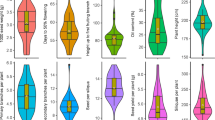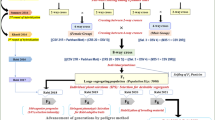Abstract
Two augmented triple test crosses were produced from inbred lines of swede (Brassica napus ssp. rapifera L.) and assessed in field trials at Dundee in 1988 and 1989, respectively. The first cross was between lines derived from cvs. Criffel and Marian and the second between the same Criffel line and one from Bangholm Wilby. The genetic architectures of the two components of dry weight yield were clearly different. Dry-matter percentage was mainly under the control of additive genetical variation whereas fresh weight yield was under the control of additive and dominance variation. Although there was unidirectional dominance (positive [h]) for high yield, the dominance ratio was less than unity in both crosses. Dry weight yield was also under the control of genes showing both additive and dominance variation. In both crosses [h] was larger than [d] and the F1 outyielded the better parent by 14 and 12 per cent, respectively. The dominance ratio was less than unity, being 0.50 and 0.94 respectively. There was no evidence of overdominance. Whilst epistasis was not a major feature of the genetic architecture of dry matter yield and its components, there were large and unexpected reciprocal differences, particularly for fresh and dry weight yield in all TTC generations and the F3 of the first cross. These require further investigation. Finally it was concluded that it should be possible to produce inbred cultivars of swede which outyield F1, hybrids in a modest sized breeding programme because 12 and 2 per cent, respectively, of the recombinant inbred lines from the two crosses were predicted to outyield the F1.
Similar content being viewed by others
Article PDF
References
Bradshaw, J E. 1988. The relative merits of lines versus hybrids in swedes (Brassica napus L. ssp. rapifera). In: Proc 7th Meeting of EUCARP1A Sec Biometrics in Plant Breeding, Birmingham, pp. 47–57.
Bradshaw, J E. 1989. Inter-plot competition in yield trials of swedes (Brassica napus ssp. rapifera L.). Euphytica, 42, 135–140.
Bradshaw, J E, and Griffiths, D W. 1990. Sugar content of swedes for stock-feeding. J Sci Food Agric, 50, 167–172.
Cavalli, L I. 1952. An analysis of linkage in quantitative inheritance. In: Reeve, E. C. R. and Waddington, C. H. (eds) Quantitative Inheritance, pp. 135–144. HMSO, London.
Davey, V McM. 1937. Root crops. Rep Scott Soc for Research in Plant Breeding, 1937, 25–28.
Davey, V McM. 1938. Root crops. Rep Scott Soc for Research in Plant Breeding, 1938, 28–31.
Davey, V McM. 1941. Root crops. Rep Scott Soc for Research in Plant Breeding, 1941, 24–26.
Davey, V McM. 1957. Root crops. Rep Scott Plant Breeding Stn, 1957, 18–24.
Denton, O A, and Whittington, W J. 1975. The response of swede varieties and their hybrids to soil pH. J Agric Sci Camb, 85, 395–401.
Denton, O A, and Whittington, W J. 1976. Genetic variation amongst swede varieties and their hybrids and their response to soil fertility. J Agric Sci Camb, 87, 443–446.
Gowers, S. 1974. The production of F1 hybrid swedes (Brassica napus ssp. rapifera) by the utilization of self-incompatibility. Euphytica, 23, 205–208.
Gowers, S. 1975. Methods of producing F1 hybrid swedes (Brassica napus ssp. rapifera). Euphytica, 24, 537–541.
Grant, I, Harney, P M, and Christie, B R. 1982. Inheritance of yield and other quantitative characters in Brassica napus var. napobrassica. Can J Genet Cytol, 24, 459–465.
Jinks, J L. 1983. Biometrical genetics of heterosis. In: Frankel, R. (ed.) Heterosis. Monographs on theoretical and applied genetics, Vol. 6, pp. 1–46. Springer, Berlin.
Jinks, J L, and Perkins, J M. 1970. A general method for the detection of additive, dominance and epistatic components of variation. III. F2 and backcross populations. Heredity, 25, 419–429.
Jinks, J L, and Pooni, H S. 1976. Predicting the properties of recombinant lines derived by single seed descent. Heredity, 36, 253–266.
Jinks, J L, and Pooni, H S. 1990. Comparing predictions of mean performance and environmental sensitivity of recombinant inbred lines based upon F3 and triple test cross families. Heredity, 45, 305–312.
Jinks, J L, Perkins, J M, and Breese, E L. 1969. A general method of detecting additive, dominance and epistatic variation for metrical traits. II. Application to inbred lines. Heredity, 24, 45–47.
Kearsey, M J, and Jinks, J L. 1968. A general method of detecting additive, dominance and epistatic variation for metrical traits. I. Theory. Heredity, 23, 403–409.
Lauder, A. 1926. The composition of swedes. Scott J Agric, 9, 160–167.
Lauder, A. 1927. The composition of swedes. Scott J Agric, 10, 428–433.
Lauder, A, and Hendrick, J. 1929. The composition of swedes. Scott J Agric, 12, 310–312.
McNaughton, I H, and Munro, I K. 1972. Heterosis and its possible exploitation in swedes (Brassica napus L. ssp. rapifera). Euphytica, 21, 518–522.
McNaughton, I H, and Thow, R F. 1972. Swedes and turnips. Field Crop Abstracts, 25, 1–12.
Mather, K, and Jinks, J L. 1982. Biometrical Genetics, 3rd edn. Chapman and Hall, London.
Munro, I K. 1982. New swede cultivars. Scott Crop Research Institute Annual Report, 1982, 68.
Pooni, H S, and Jinks, J L. 1979. Sources and biases of the predictors of the properties of recombinant inbreds produced by single seed descent. Heredity, 42, 41–48.
Pooni, H S, Jinks, J L, and Cornish, M A. 1977. The causes and consequences of non-normality in predicting the properties of recombinant inbred lines. Heredity, 38, 329–338.
Ramsay, L D. 1991. Application of Biometrical Genetics to Swede Breeding. Ph. D. Thesis, University of Birmingham.
Author information
Authors and Affiliations
Rights and permissions
About this article
Cite this article
Ramsay, L., Bradshaw, J. & Kearsey, M. The inheritance of quantitative traits in Brassica napus ssp. rapifera(swedes): augmented triple test cross analysis of yield. Heredity 73, 84–91 (1994). https://doi.org/10.1038/hdy.1994.102
Received:
Issue date:
DOI: https://doi.org/10.1038/hdy.1994.102



